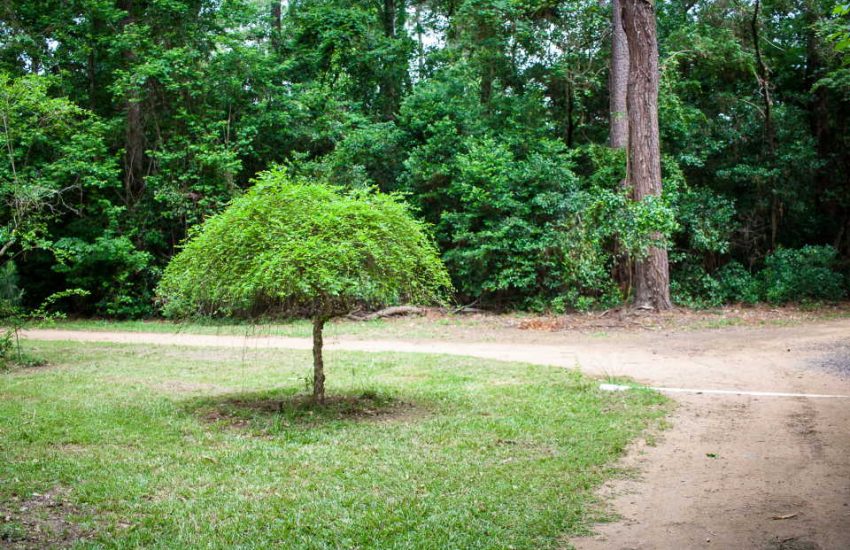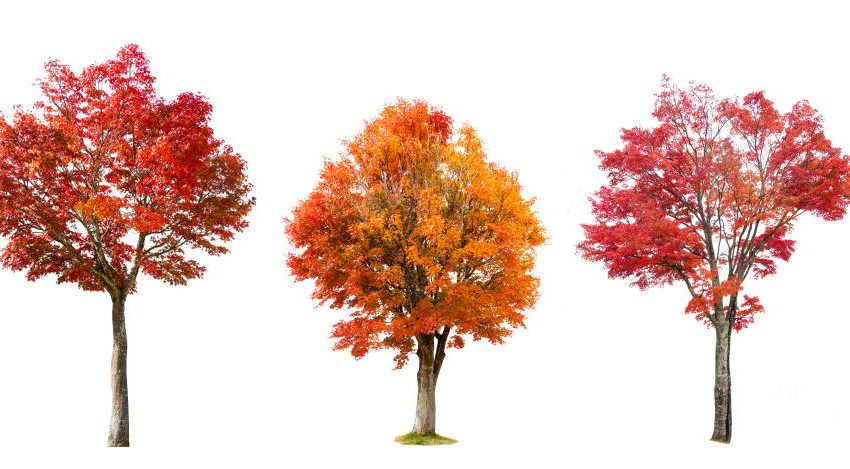10 Ground Cover Plants to Grow in South Carolina
Ground covers are considered low-growing plants that turn into dense mats as they grow and protect the soil against erosion, not forgetting their capacity to help retain soil moisture. The lawn is the most widely planted ground-cover plant, but it is always nice to get out of your comfort zone and have something different cover the ground. Typically, a ground cover is any low-spreading plant that looks like a shrub or a small palm.
Ground covers are used to add a shade of beauty to the landscape, and settling on the perfect ground cover plant to grow widely depends on the area. Some of them prefer to grow in the shade, while other types thrive in the sun. While others might opt to do well in the well-drained or dry soil, some ground covers choose to stick to the moist soil.
Moreover, landscapers can also plant ground covers along the planting bed borders’ and use them to fill gaps or achieve a more layered, fuller garden bed. Ground covers can stay for several years in the same spot they were first planted; hence it is important to ensure that the ground is well prepared so that the plants can establish a good rooting system. The following are some of the ground cover plants to grow in South Carolina.
1. Carolina Jessamine
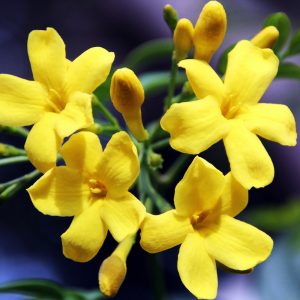
Carolina jasmine plants are sprawling vines native to South Carolina, where there are hot summers and mild winters. They tend to twine around anything and can adapt well to various settings. They have dark green, glossy leaves that provide a dense coverage for whatever structure they cling on, and their vines have clusters of fragrant, yellow flowers as the late spring or spring winters approach. You can plant them along fences, on arbors and trellises, or under trees possessing loose canopies.
Although they are a vigorous climber, their vines trail on the ground to form a carpet-like cover and are planted on steep banks to prevent soil erosion. In addition, Carolina jasmine tolerates partial shade, where they may grow at a sluggish pace and become leggy but can also thrive in sunny locations. For the perfect outcome, ensure you grow them in organically rich, fertile, and well-drained soil where the compost is available in generous amounts.
As much as they can tolerate drought conditions, Carolina jasmine appears to be in its best shape when it is regularly watered and its vines annually fertilized in spring using a general-purpose commercial fertilizer. If left unattended, they can adapt to a wild appearance with most of the flowers and foliage at the vine tops. Encourage a fuller growth of the plant by cutting back the vine tips after the fading of the flowers and the stem’s lower parts.
2. Mountain Spurge

This ground cover spreads by underground runners and thrives in partial to full shade. They are shrubby and tend to grow into a dense carpet of blue-green leaves marbled with purple and silver. Their evergreen stems form upright clumps, and their foliage tends to be semi-green to evergreen in USDA zones 7 to 9 and deciduous in zones 5 and 6. They produce fragrant white flower spikes that are 5-10cm long and appear before the emergence of new leaves during the early to late spring.
These ground cover plants are useful in woodland gardens, shady areas, and shrub borders and are favorable in all types of soil except extremely dry soils. The mountain spurge is more attractive and less aggressive than the Japanese spurge. However, when exposed to too much sun, the foliages change to yellow, and the whole plant experiences poor growth. Many consider this forgiving perennial to be deer resistant because it is hardy and low maintenance.
If eaten, the plant can prove to be hazardous and fatal to animals, but it does not have serious cases of pests and disease. However, watch for common pests such as slugs, mites, and leaf blights. If protected from cool winds, there are chances of it remaining evergreen. If you need softwood cuttings, you may try taking them down during the early summer or spring.
3. Thyme
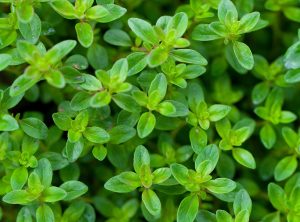
Thyme is an evergreen ground cover plant with white or pink flowers and fragrant foliage during the summer or spring. Many prefer to plant thyme as a lawn substitute or create a living patio with them by planting them among pavers or stones. The thyme appears as dense mats, low and sprawl rapidly and randomly to fit the ground live a cover. Moreover, the creeping thyme is kid resistant and can withstand any form of tromping. Because of this, thyme is the best choice of ground cover to have in areas where there is a lot of traffic.
Although it has a pleasant odor, thyme is deer resistant hence an ideal candidate in areas they are frequent. If you want to plant them, you can get them from a local nursery as already-established seedlings or plantings. The ideal height for planting them is 8 to 12 inches, and cuttings ought to be taken during the early summer. When starting to grow thyme, start with the seeds in the house or have them sown after the passing of the frost danger during the spring season.
To maintain the thyme’s compact appearance, carry out the pruning in the spring. If you need additional pruning, you can also carry it out after spending the small, white flowers.
4. Lamium

Not only is Lamium fast-growing, but it is also one of the most attractive ground covers and is sometimes referred to as the spotted dead nettle. The leaves of this plant are sometimes serrated or tear-shaped, and it belongs to the mint family. If you are struggling with your lawn, the Lamium ground cover plant is a beautiful alternative because it requires almost little to no maintenance and contributes to brightening up shady cornet because of its silver-marked, eye-catching green foliage.
Lamium tolerates almost all soil types, is a versatile ground cover plant, and is evergreen for most parts of the year. However, Lamium tends to grow rapidly in humus-rich, slightly moist soils. Most people grow it from nursery plants, and it can cover up a space within four to five years. Before germination, Lamium seeds must be taken through a chilling period; refrigeration for at least 10 weeks is ideal.
This ground cover plant can be multiplied through:
● Division: during spring, dig out the plant, separate it, and replant them separately while being keen to space 6 inches apart.
● Stem layering: achieve this by pushing a stem into the ground and lev only the tip out after covering it partially with soil.
● Cuttings.
When grown in hot climates or during the summer, its leaves become withered, brown, and scorched; hence best to grow it in full-to partial shade. Most soil types accommodate Lamium, provided favorable drainage occurs, and the pH is between 6.0 and 7.0. Consider amending the soil with lime in case it is acidic. As new growth is experienced during the spring, keep Lamium fertilized with an all-purpose fertilizer and repeat this mid-summer.
5. Shrubby St. John’s Wort
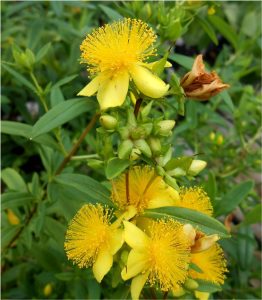
It is a small, medium-sized deciduous, spreading shrub growing up to 4 feet wide and in height. The ground cover plant has upright branching with blue-green leaves and a purple to red bark. Naturally, the plant has dense foliage of small and slender leaves and constitutes a mounded form. Ideally, it is best to prune it during the spring season because of this. As much as its growth rate is slow compared to other species o ground cover plants, the shrub is definitely worth it because of its hardy nature; it is highly adaptable and is a favorite of almost all soil types, including heavy clay.
The shrub produces cheerful yellow flowers, which attract pollinators and act as food for the birds during the winter season. However, pruning is recommended during the early spring as the flowering only occurs on new wood.
6. Carpet Bugleweed
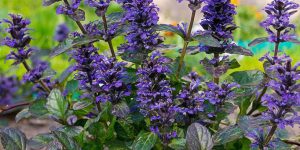
If you have a large bare area of land that needs to be filled, carpet bugleweed is the best ground cover plant for you. This creeping evergreen specie of plant smothers weeds and fills empty areas in no time. Moreover, it has an exceptional color of foliage and is ideal for controlling soil erosion. The eaves can either be variegated with white and pink, purple or green, and the foliage receives lovely spikes of white, pink or blue flowers during the spring.
Multiplication happens faster after they start to grow, and it thrives in well-drained, fertile soil with quality air circulation. So if you are looking for a plant to add year-round interest to your landscape, the carpet bugleweed is the one to go for.
7. Hosta
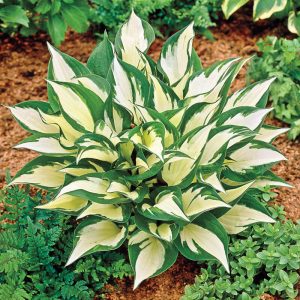
Hosta Loyalist
visi24610.jpg
B_OTP01445.tif
SKU 69089
When planted under a shady garden, it appears in variegated greens and attracts pollinators during the early spring or summer when it blooms. They are hardy perennials with no need for extra attention and are ideal for gardens that receive partial sun amounts. Hosta is versatile and available in a variety of textures, heights, colors, and sizes. Moreover, the ground cover plant is perfect for gardens such as rock, containers, borders, shade, and patios.
Hosta is mostly preferred because it has a good fragrance and produces lander, blue, white, or pink flowers from early summer to early fall. Besides being loved by humans, hostas are also loved by rabbits, slugs, deer, and snails.
8. Lady’s Mantle
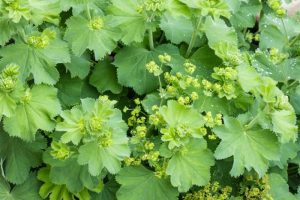
This ground cover plant is characterized by yellow-green flowers and huge scallop-edged leaves and can primarily succeed in the shade and thrive under partial sunlight. If kept in bounds, Lady’s mantle produces a nice edging and can sometimes be found in freshly cut or dried bouquets and wreaths. Ideally, it can grow 2 inches from the ground and require areas with a large and bare space. It comprises semi-round, gray-green foliage and produces inconspicuous chartreuse in late spring.
It provides landscapes with an interesting background, and its roots and leaves were used for medicinal purposes where the harvesting took place in midsummer and was used to treat wounds and bruises. This ground cover plant thrives in cool summer regions under moist and fertile soil. The plant has the potential to do better in shady areas, although it can also perform in full sun. While planting, ensure you leave enough room for their rapid expansion and add fertilizer at the base of the planting hole while observing frequent watering for robust growth.
9. Mondo Grass
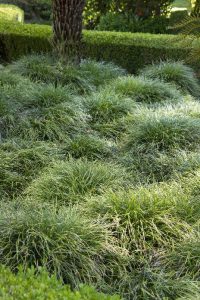
Also referred to as the monkey plant, this perennial plant is evergreen and is a good choice for ground covering. They are slow-growing and perform well in almost all soil types; it is easily propagated through division and under minimal maintenance and care once they are well established. Being hardy, the grass is deer resistant but may potentially fail under inadequate moisture amounts. However, it is versatile and has a variety of uses for the farmer. For example, summer may brighten the landscape by producing white or lavender flowers, which become glossy black fruits.
Mondo grass is a great alternative to lawns because it requires no mowing. Furthermore, it constitutes underground stems, spread through stolons, and forms dense colonies when fully grown.
10. Moss Pink

It is an evergreen ground-covering plant that grows up to 6 inches and is made up of creeping woody stems and needlelike leaves. Its flowers are star-shaped and come in white, pink, purple, dip pink or blue colors. They bloom during the mid-spring to early summer depending on whether the local climate is favorable and are easy to take care of; hence require minimal care once they are established into the soil. Ensure they have good drainage and propagate through cuttings, layering, or division.
It is ideal for providing cover in rocky gardens and the go-to choice of a ground cover plant if you need your landscape to look like a green carpet.
People prefer to go ground cover plant and do away with grass because they potentially cover a large area with minimal effort and require no mowing. Moreover, lawn maintenance can be tedious, so replacing this with a colorful ground cover is the best choice. These plants prevent soil erosion and drought by using their roots to hold the soil, especially on a steep slope. The initial costs of installing ground covers can be high; hence, engaging with plants native to your area is cost-effective.
If you are in South Carolina and searching for the best ground-covering plants, ensure you pay a visit to your local cooperative extension service and learn about the available variety of the best ground covers.

